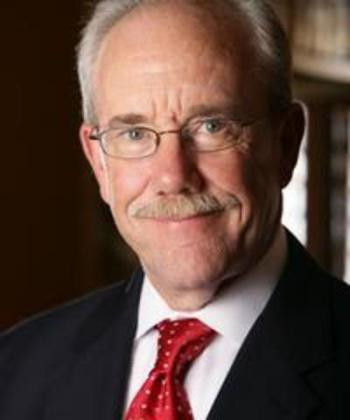By TAMI QUIGLEY Staff writer
“Today we assume places of Christian worship are richly decorated, but that was not always the case,” said Dr. Thomas F.X. Noble, presenting the Hesburgh Lecture, “Faith Taking Shape: Early Christianity and the Arts,” April 29 at DeSales University, Center Valley. The lecture was rescheduled from Feb. 20 because of snow.
The Notre Dame Club of the Lehigh Valley presented the event, which was co-hosted by the Salesian Center for Faith and Culture at DeSales.
Noble is professor emeritus of history at the University of Notre Dame, South Bend, Ind., and a fellow at the Nanovic Institute for European Studies at Notre Dame.
“The emergence of Christian art was accompanied by criticism of it,” Noble said during the evening presentation in the University Center.
“In the late second century and early third century, distinctive Christian images began to appear but were abstract and impersonal,” Noble said.
Examples of these were the fish, called “Jesus Christ, Son of God, Savior,” the Good Shepherd and a lamb.
Noble said attitudes emerged about art, and some art was permitted.
“From the dawn of the fourth century, Christian art expanded from images on ordinary objects to magnificent structures,” he said.
“Art and theology were beginning to share perspectives.”
As Noble discussed how Christian figural art began to emerge, he showed early representations of Christ from Rome in the years circa 350 to 360, and in Ravenna, Italy in the fifth century. In these, Christ had short curly hair, did not have a beard and looked like a philosopher.
Gradually, depictions showed Christ as older and bearded – “The Normative Christ” – such as in Rome at the Basilica of Santi Cosma e Damiano in the fifth century, and at the Basilica of St. John Lateran in the fifth and sixth centuries. Christ was also depicted in the Book of Kells circa the year 800.
Ernest Salman, a German Lutheran, created the most copied image of Christ in history in 1939. “It was hung and is still hanging in many dining rooms,” Noble said.
Christ was also depicted as a lamb, such as in the Basilica of San Vitale, Ravenna, circa 540, and by Francisco de Zobaran in the 1600s.
Noble spoke about Marian images, such as the Eleusa, a type of depiction of the Virgin Mary in icons in which the infant Jesus Christ is nestled against her cheek. In the Western Church the type is often known as the Virgin of Tenderness.
He showed an image of the Virgin of Vladimir from Constantinople in 1100, noting “Mary is holding Jesus in a private moment.”
Noble also showed images of the Eleusa by Filippo Lippi, circa 1420-69, and the famous one by Raphael in 1515, of which he asked, “How many of you have had this one on your Christmas cards?”
“There was consistency once a tradition of images emerged,” Noble said.
Noble said there was no cross in the early crucifixion images of the fourth century. “It took Christians a long time to portray the crucifixion – for them it was humiliating.” The fifth century saw the first depiction.
Christ’s head was erect and his eyes open in the crucifixion representation at St. Catherine’s, Sinai, Constantinople circa 800. His head was down on the Gero Cross in Cologne, Cathedral, Germany circa 970. Christ’s head was also down in Matthias Grunewald’s depiction in 1500, “which became the way the crucifixion was depicted.”
Noble also showed Salvador Dali’s 1951 depiction of the crucifixion, “Christ of Saint John of the Cross.” This painting depicts Jesus Christ on the cross in a darkened sky floating over a body of water complete with a boat and fishermen.
Noble earned his bachelor of arts degree at Ohio University, and his master of arts and doctorate degrees at Michigan State.
For 41 years he taught classical and medieval history at Texas Tech, the University of Virginia and at Notre Dame. He has published and lectured widely on both Europe and the Mediterranean world.
He is author or editor of 12 books and a fellow of the Medieval Academy of America. He won the University of Virginia’s Alumni Distinguished Professor Award in 1999; Notre Dame’s Edmund P. Joyce, C.S.C., Award for Excellence in Undergraduate Teaching in 2008; and the Charles Sheedy, C.S.C., Award for Excellence in Teaching in the College of Arts and Letters in 2011.
His research has concentrated on late antiquity and the early Middle Ages, focusing on the history of the city of Rome, the history of the papacy, and the age of Charlemagne. Inspired by the late Father Hesburgh’s example of lifelong learning, the Hesburgh Lecture Series has brought university faculty to Notre Dame clubs and their local communities since 1986.
The lectures, presented by mostly tenured faculty, showcase the depth and breadth of Notre Dame’s academic expertise in research and teaching through an accessible format suitable for a general audience. The Hesburgh Lecture Series furthers the mission of the Alumni Association to provide meaningful continuing education opportunities to Notre Dame alumni and friends.








